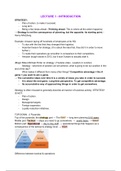Samenvatting
Summary TBB Fashion strategies Lectures
- Vak
- TBB Fashion
- Instelling
- Hogeschool Van Amsterdam (HvA)
Complete summary of the lectures: - Introduction (strategy) - Burberry - Prada - Theory I - Theory 2: Evolution of strategic models in fashion - Theory 3: Theoretical frameworks - Theory 4: Diesel Case - Theory 5: AI and fashion marketing
[Meer zien]




